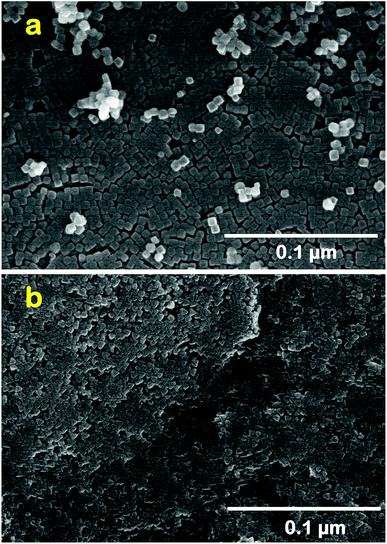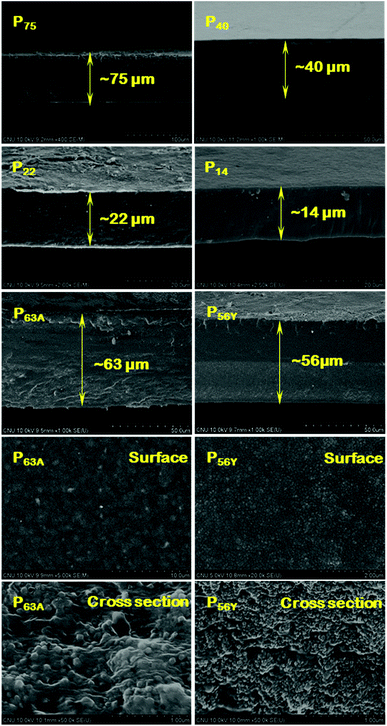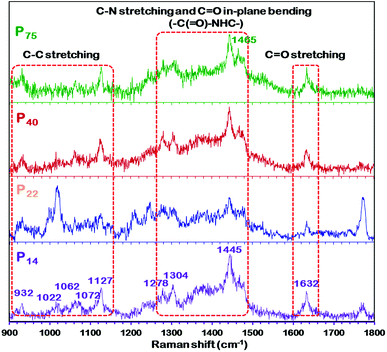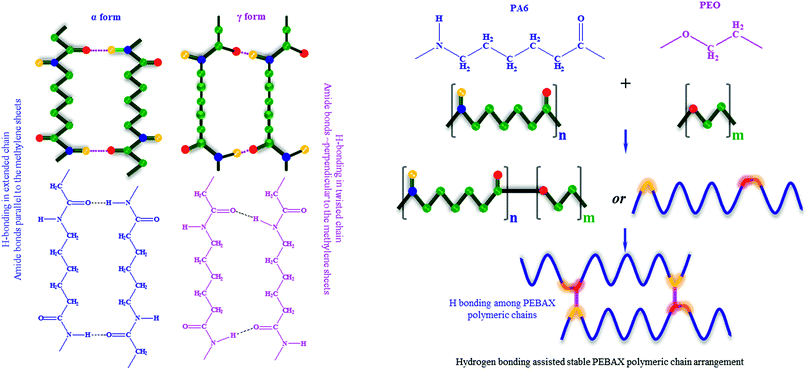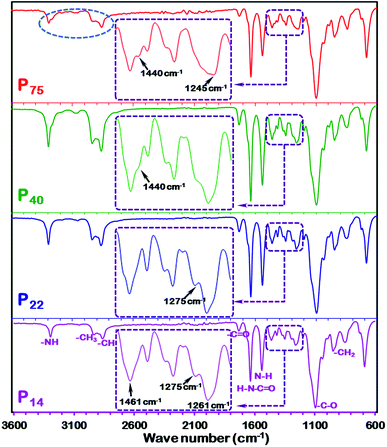 Open Access Article
Open Access ArticleCreative Commons Attribution 3.0 Unported Licence
A stable polymeric chain configuration producing high performance PEBAX-1657 membranes for CO2 separation†
Pankaj
Sharma
 *,
Young-Jin
Kim
,
Min-Zy
Kim
,
Syed Fakhar
Alam
and
Churl Hee
Cho
*,
Young-Jin
Kim
,
Min-Zy
Kim
,
Syed Fakhar
Alam
and
Churl Hee
Cho
 *
*
Graduate School of Energy Science and Technology, Chungnam National University, 99 Daehak-ro, Yuseong-gu, Daejeon 34134, Republic of Korea. E-mail: sharmapankaj47@yahoo.com; choch@cnu.ac.kr
First published on 14th May 2019
Abstract
Although PEBAX-1657 is one of the promising polymeric materials for selective CO2 separation, there remain many questions about the optimal polymeric structure and possibility of improving performance without adulterating its basic structure by impregnating inorganic fillers. In order to improve the gas separation performance, low thickness PEBAX membranes were synthesized under steady solvent evaporation conditions by keeping in mind that one of its segments (nylon 6) shows structural variance and molecular orientation with a change in the evaporation rate. Furthermore, phase pure zeolite nanocrystals with cubic (zeolite A) and octahedral (zeolite Y) shapes have been synthesized through liquid phase routes using microwave hydrothermal reactors. The average sizes of zeolite A and Y crystals are around 55 and 40 nm, respectively. The inspection of XRD, DSC and Raman shift of PEBAX membranes demonstrates the formation of a stable polymeric structure with an improved crystalline state which results in high CO2 permeability membranes. The CO2 permeability as well as diffusivity increase with a decrease in membrane thickness and reach a maximum value of 184.7 Barrer and 2.6 × 10−6 cm2 s−1, respectively. The as-fabricated pristine PEBAX membrane shows much better performance in terms of permeance (CO2 184.7 Barrer), diffusivity (CO2 2.6 × 10−6 cm2 s−1) and selectivity (CO2/N2 59.7), which substantiate its promising prospects for CO2 capture. This exceptional performance of the pristine PEBAX membrane arises from the free volume generated during the steady polymerization. This reported approach for PEBAX membrane synthesis provides a direction in the design of membrane fabrication processes for economic CO2 separation.
1. Introduction
Global warming is mainly caused by the emission of greenhouse gases and 72% of the total emitted greenhouse gases are carbon dioxide (CO2), 18% methane and 9% nitrous oxide (NOx). Therefore, CO2 emission is the primary cause of global warming, and human activities are mainly responsible for greenhouse gas emission into the earth environment.1 Thus, CO2 capture, separation, and storage have been considered as one of the most important technological efforts to combat the global warming challenge. Compared to well-known technologies for CO2 capture including amine scrubbing, solid adsorption, solvent adsorption, and cryogenic distillation, membrane separation is more promising due to its system compactness (small footprint), ease of operation, least environmental impact and exceptional reliability.2–10 Particularly, the amine scrubbing based post-combustion CO2 capture process has large human health and environmental concern because of solvent emissions during the processing. Furthermore, a high amount of energy is needed for CO2 desorption which results in efficiency loss in the case of amine-based scrubbing.Inorganic and polymeric membranes are two major players for CO2 capture.11 Although, inorganic membranes have also been extensively investigated for gas separation due to their exceptional separation performance and incredible thermal and chemical stability, their cost and lack of processability are the major issues for their large-scale production. Furthermore, assembling of inorganic membranes into high packing density membrane modules is critical for the flue gas process. On the other hand, polymeric membranes have emerged as an ideal candidate for large scale processing plants.12,13 However, polymer-based membranes have a major drawback, the so-called permeability–selectivity trade-off, i.e., either increase in permeability or decrease in selectivity or vice versa.14
To address these issues and to prepare novel membranes/materials, researchers made attempts to combine the merits of polymeric and inorganic materials to develop a new class of membranes.14–23 Poly(ether-block-amide) polymer commonly known as PEBAX is considered as one of the ideal polymeric materials for membrane-based separation of CO2 from flue gas and natural gas because of its comparatively high gas permeability as well as CO2 selectivity.1,16,24–38 PEBAX consists of two monomers polyethylene oxide (PEO) and polyamide (PA), where the earlier component provides flexibility and high CO2 permeability due to its high affinity with the polar CO2 molecule, while the latter component imparts mechanical strength to the membrane. As ether oxygen moieties have a significant affinity to acid gases, PEBAX is considered as one of the best candidates for CO2 separation from light gases.24,32 The perfect balance between permeability and CO2 selectivity can be achieved by increasing the free flow of gas molecules through the polymeric membrane without altering the surface structure of the polymer.
Polymer free-volume, the fraction of the volume not occupied by the electronic clouds of the polymer, plays an important role in the transport properties of low molecular weight species and gases. In other words, molecular transport through a dense polymer depends strongly on free volume; therefore, control over free-volume is thus important for the development of better membranes for a wide variety of applications such as gas separation, pharmaceutical purification, and energy storage.13,15,24,39–43 Free volume (i.e., static voids created by inefficient chain packing or transient gaps generated by thermally induced chain segment rearrangements) presents diffusing molecules with a low resistance avenue for transport.15,39,40,44–47 Not only the overall amount of free-volume but also the distribution of the effective micropore size is likely to have a significant influence on polymer properties if the free-volume elements are interconnected. The use of inorganic fillers in mixed matrix membrane (MMM) is to influence the free volume.15,24,40 However, the addition of cost-ineffective nano-size inorganic fillers generally shows negative effects on the selectivity with little improvement in permeability. If the addition of nano-inorganic fillers is just to improve the permeability of the membrane, then it is better to find an alternative method to achieve the same. Recently, ultrathin supports have been utilized to develop high performance polymer composite membranes.48–53
In this reported paper, attempts have been made to improve the permeability as well as CO2 selectivity of the PEBAX-1657 membrane by improving the polymeric structure and controlling the free volume of the membrane. This work reflects that the free volume of the PEBAX-1657 membrane can easily be controlled by controlling the polymer chain conformation. Furthermore, to ascertain the structural as well as chemical reforms in the as-fabricated pristine PEBAX membrane elaborate diffraction, electron scanning, thermal, spectroscopic, etc., analyses were conducted. Moreover, a number of experiments were performed to compare the selectivity of pristine PEBAX-1657 membranes with that of nano-molecular sieves (Scheme 1) embedded mixed matrix membranes (MMMs).
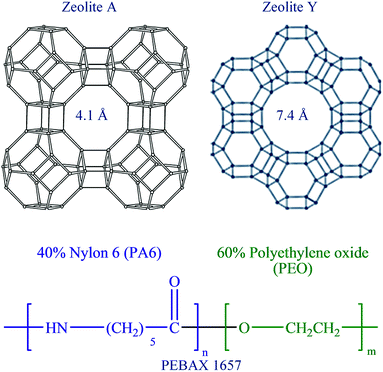 | ||
| Scheme 1 Zeolite framework structures representing the channel diameter of zeolites Y and A, whereas the chemical structure of PEBAX 1657 displays the composition of monomers. | ||
2. Experimental
2.1 Materials
Commercially available PEBAX® 1657 was used for membrane synthesis. The chemicals used for nano-size NaA and NaY zeolite molecular sieve synthesis, membrane preparation, and performance evaluation were as follows: tetramethylammonium silicate (TMAS) ((CH3)4N(OH)·2SiO2, 15–20 wt%, ≥99.99%, Aldrich), colloidal silica suspension (CSS) (SiO2, LUDOX®HS-30 colloidal silica, 30 wt% suspension in H2O, Aldrich), aluminium isopropoxide (Al(OCH(CH3)2)3, ≥98%, Aldrich), tetrametylammonium hydroxide (TMAOH) pentahydrate ((CH3)4N(OH)·5H2O, 98%, Alfa Aesar), tetrametylammonium bromide (TMABr) ((CH3)4N(Br), 98%, Sigma Aldrich), sodium hydroxide (min. 97%, Junsei Chemical Co. Ltd., Japan), and ethanol (EtOH) (99.9% absolute, OCI company Ltd.). All chemicals used in this study were of analytical grade and ultrapure water (0.054 μS cm−1) obtained from a μPure system (ROMAX, Human Science, Republic of Korea) was used throughout the experiments. Ultra-high purity grade CO2, O2, N2, and CH4 gases were used for single gas permeation experiments.2.2 Zeolite molecular sieve synthesis
Zeolite molecular sieves (zeolite A (LTA type) and zeolite Y (FAU type)) having different porous characters (structure and size) and Si/Al ratios have been synthesized through liquid phase routes using a microwave hydrothermal reactor (CEM, Discover-909150, maximum power of 300 W). Detailed synthesis conditions with chemical compositions and their structural properties have been summarized in Table 1. After the synthesis, the resultant milky suspensions containing nano-size zeolite molecular sieves were cooled to room temperature and diluted with deionized water. The resulting nano-crystals were then separated from the mother liquor by high speed centrifugation at 20![[thin space (1/6-em)]](https://www.rsc.org/images/entities/char_2009.gif) 000 rpm for 20 min at 4 °C followed by repeated re-dispersion in deionized water and centrifugation (washing step was repeated 5 times). To avoid the aggregation or coagulation of the nano-particles during drying, the finally collected wet zeolite particles were directly dispersed in DIW. The reported percentage of zeolite molecular sieves loaded on PEBAX-1657 membranes was directly obtained from the wet sample.
000 rpm for 20 min at 4 °C followed by repeated re-dispersion in deionized water and centrifugation (washing step was repeated 5 times). To avoid the aggregation or coagulation of the nano-particles during drying, the finally collected wet zeolite particles were directly dispersed in DIW. The reported percentage of zeolite molecular sieves loaded on PEBAX-1657 membranes was directly obtained from the wet sample.
| Zeolite | Molar composition of the reaction mixture | Si/Al ratio | Silica source | Synthesis conditions | Structural properties | ||||
|---|---|---|---|---|---|---|---|---|---|
| Aging | Crystallization | Pore size, Å | Ring size, membered | ||||||
| Temp. °C | Time, h | Temp. °C | Time, h | ||||||
| NaA | 2.0SiO2![[thin space (1/6-em)]](https://www.rsc.org/images/entities/char_2009.gif) : :![[thin space (1/6-em)]](https://www.rsc.org/images/entities/char_2009.gif) 1.0Al2O3 1.0Al2O3![[thin space (1/6-em)]](https://www.rsc.org/images/entities/char_2009.gif) : :![[thin space (1/6-em)]](https://www.rsc.org/images/entities/char_2009.gif) 2.2TMAOH 2.2TMAOH![[thin space (1/6-em)]](https://www.rsc.org/images/entities/char_2009.gif) : :![[thin space (1/6-em)]](https://www.rsc.org/images/entities/char_2009.gif) 0.16Na2O 0.16Na2O![[thin space (1/6-em)]](https://www.rsc.org/images/entities/char_2009.gif) : :![[thin space (1/6-em)]](https://www.rsc.org/images/entities/char_2009.gif) 130.0H2O 130.0H2O |
1.0 | TMAS | 25 | 24 | 150 | 2 | 4.1 | 8 |
| NaY | 4.5SiO2![[thin space (1/6-em)]](https://www.rsc.org/images/entities/char_2009.gif) : :![[thin space (1/6-em)]](https://www.rsc.org/images/entities/char_2009.gif) 1.0Al2O3 1.0Al2O3![[thin space (1/6-em)]](https://www.rsc.org/images/entities/char_2009.gif) : :![[thin space (1/6-em)]](https://www.rsc.org/images/entities/char_2009.gif) 5.0TMAOH 5.0TMAOH![[thin space (1/6-em)]](https://www.rsc.org/images/entities/char_2009.gif) : :![[thin space (1/6-em)]](https://www.rsc.org/images/entities/char_2009.gif) 2.5TMABr 2.5TMABr![[thin space (1/6-em)]](https://www.rsc.org/images/entities/char_2009.gif) : :![[thin space (1/6-em)]](https://www.rsc.org/images/entities/char_2009.gif) 0.05Na2O 0.05Na2O![[thin space (1/6-em)]](https://www.rsc.org/images/entities/char_2009.gif) : :![[thin space (1/6-em)]](https://www.rsc.org/images/entities/char_2009.gif) 250H2O 250H2O |
2.25 | CSS | 25 | 72 | 100 | 96 | 7.4 | 12 |
2.3 Membrane synthesis
Fig. S1, ESI† presents the stepwise preparation procedure for the pristine PEBAX and double layer PEBAX/nano-molecular sieve MMMs. PEBAX® 1657 pellets were dissolved in EtOH![[thin space (1/6-em)]](https://www.rsc.org/images/entities/char_2009.gif) :
:![[thin space (1/6-em)]](https://www.rsc.org/images/entities/char_2009.gif) H2O (70
H2O (70![[thin space (1/6-em)]](https://www.rsc.org/images/entities/char_2009.gif) :
:![[thin space (1/6-em)]](https://www.rsc.org/images/entities/char_2009.gif) 30 wt%) solvent at 80 °C for 2 h with high speed stirring in a microwave hydrothermal reactor to obtain 2.5% PEBAX solution. Different thickness membrane films were obtained by pouring different amounts of polymer solution into a Teflon Petri dish (ϕ 85 mm). Subsequently, the polymer solution containing Teflon Petri dish was covered with filter papers (F1113 grade, Chmlab) to slow down the evaporation of solvent allowing the formation of a polymeric membrane with uniform thickness and better crystallinity. The polymeric solution was dried for 2 days at 40 °C. Once dried, the film was placed under vacuum for 24 h for complete solvent removal from the film. After this period, the film was allowed to cool to room temperature under vacuum. A 50 mm diameter circular sample was cut from the film and used for permeation tests, whereas, the PEBAX/nano-molecular sieve MMMs were fabricated by just casting the inorganic filler suspension in 1% PEBAX solution (EtOH
30 wt%) solvent at 80 °C for 2 h with high speed stirring in a microwave hydrothermal reactor to obtain 2.5% PEBAX solution. Different thickness membrane films were obtained by pouring different amounts of polymer solution into a Teflon Petri dish (ϕ 85 mm). Subsequently, the polymer solution containing Teflon Petri dish was covered with filter papers (F1113 grade, Chmlab) to slow down the evaporation of solvent allowing the formation of a polymeric membrane with uniform thickness and better crystallinity. The polymeric solution was dried for 2 days at 40 °C. Once dried, the film was placed under vacuum for 24 h for complete solvent removal from the film. After this period, the film was allowed to cool to room temperature under vacuum. A 50 mm diameter circular sample was cut from the film and used for permeation tests, whereas, the PEBAX/nano-molecular sieve MMMs were fabricated by just casting the inorganic filler suspension in 1% PEBAX solution (EtOH![[thin space (1/6-em)]](https://www.rsc.org/images/entities/char_2009.gif) :
:![[thin space (1/6-em)]](https://www.rsc.org/images/entities/char_2009.gif) H2O: 70
H2O: 70![[thin space (1/6-em)]](https://www.rsc.org/images/entities/char_2009.gif) :
:![[thin space (1/6-em)]](https://www.rsc.org/images/entities/char_2009.gif) 30) on a dried PEBAX film as shown in Fig. S1, ESI† followed by drying. Casting of inorganic molecular sieves on the polymeric film instead of mixing with polymer solution was performed to avoid the void formation between the high concentration polymer and inorganic particles at their interface. The resultant membranes were denoted as P75, P40, P22, P14, P63A, and P56Y, where digits in the subscript represent the thickness of the membrane and letters molecular sieves.
30) on a dried PEBAX film as shown in Fig. S1, ESI† followed by drying. Casting of inorganic molecular sieves on the polymeric film instead of mixing with polymer solution was performed to avoid the void formation between the high concentration polymer and inorganic particles at their interface. The resultant membranes were denoted as P75, P40, P22, P14, P63A, and P56Y, where digits in the subscript represent the thickness of the membrane and letters molecular sieves.
2.4 Zeolite particles and membrane characterization
Powder X-ray diffraction studies of the nano-molecular sieves and PEBAX membranes were performed on a PANalytical: X'Pert PRO diffractometer with Cu-Kα radiation (λ = 1.5418 Å) and the data were collected in the 2θ range of 5–60° with a step size of 0.02° s−1. Phase identification for zeolites A and Y was performed with the help of JCPDS files for inorganic compounds (LTA #97-002-4901 and FAU # 98-003-4277). The morphological characteristics, particle size, and membrane thickness were evaluated with a scanning electron microscope (SEM, JEOL-JSM-7000F). The membrane samples were prepared by fracturing the membrane in liquid nitrogen and subsequent sputter coating of palladium. The average particle size and particle size distributions of the inorganic fillers were measured by light scattering analysis (Nanotrac Wave, Microtrac, Inc.) at 298 K. Transmission electron microscopy (TEM) images were obtained using an FEI Tecnai™ G2 F30 electron microscope, operating at 300 kV. The particle size distribution (PSD) in volume percent was calculated by using Microtrac FLEX 11 operating software. The thermal properties and glass transition temperatures (Tg) of pristine PEBAX membranes were determined using a differential scanning calorimeter (DSC) (TGA/DSC 1 STARe system METTLER TOLEDO instruments). The measurements were carried out using a standard heating–cooling–heating procedure at a rate of 10 K min−1 in a nitrogen atmosphere. Furthermore, the chemical structure of the as-fabricated PEBAX membranes was characterized by using Raman spectra, which were recorded by using a LabRAM HR Evolution 800, Raman Spectrometer from Horiba Scientific (785 nm diode laser excitation). Fourier transform infrared spectroscopy (FTIR, ALPHA-Platinum ATR, Bruker) spectra of pristine PEBAX membrane samples were recorded in the range of 600–3600 cm−1 with a resolution of 1.4 cm−1 (64 scans) to assert the changes in the polymeric chain conformation. Water vapor adsorption/desorption experiments were performed at 298 K using an automatic adsorption measurement apparatus, BELSORP-max (BEL Japan, Inc.), and each sample was outgassed for 6 h at 423 K before analysis. A ∼66 point water vapor adsorption/desorption isotherm has been recorded and used for surface area and total pore volume calculation. The experimental values of membrane density were determined at 25 °C using Archimedes' principle with an electronic balance (Mettler Toledo XS205) equipped with a density measurement kit. An auxiliary liquid, silicon oil (ρo = 0.913 g cm−3), with known densities was used to evaluate the density, and to affirm the variation in fraction free volume (FFV). A piece (approximately 4 cm2) of each polymeric membrane was introduced into a sample pan and basket for weight measurement in air and the liquid phase, respectively. Considering some degree of hydrophilicity of the PEBAX membrane, two different fluid (de-ionized water and silicon oil) were selected to minimize the source of error due to the liquid–polymer interaction over the time scale of equilibration during weight measurement. The experimental values of density (ρp) were calculated by using the following equation:| ρp = (Wair/(Wair − Wliquid))ρo | (1) |
The fraction free volume (FFV) and specific free volume (SFV) of pristine PEBAX membranes were calculated using the following equations based on the density data:24
| FFV = 1 − 1.3νwρp | (2) |
| SFV = 1/ρp − 1.3νw | (3) |
2.5 Gas permeation measurement
The permeability of the polymeric membranes and MMMs were measured at room temperature (25 °C) and at a feed pressure of 2.7 bar using a single gas with a fixed-volume pressure increase instrument.54 The permeability was measured directly and the time lag method was applied to the recorded data to determine the diffusivity coefficient. The solubility coefficient was taken as the ratio of the permeability to the diffusivity coefficient. The schematic diagram of the permeation system is shown in Fig. 1. A flat sheet circular cell affixed with a mesh to support the membrane of effective area 15.2 cm2 was placed in a thermostat oven to control the temperature. Before analysis, the membranes were evacuated for at least 24 h to remove the previously adsorbed species. Moreover, to achieve accurate temperature apart from the gas cylinder, all other equipment/pipelines were installed inside a thermostat oven as shown in Fig. 1.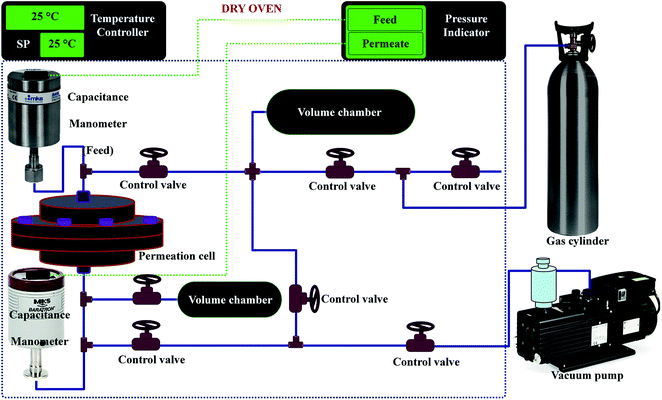 | ||
| Fig. 1 Schematic diagram of the experimental set-up (time-lag machine) for the single gas permeation. | ||
Gas transport in dense polymer membranes can be described by the solution–diffusion mechanism, in which the gas penetrants are absorbed into the membrane from the upstream feed and then diffuse through the membrane to the downstream permeate.28,36 Permeability (P) is an intrinsic property of the membrane material, which can be written as the product of diffusivity (D) and solubility coefficient (S):
| Pi = DiSi | (4) |
In the ideal case of mass transport, P, D, and S are independent of feed/permeate pressure. Therefore, the selectivity of a polymer membrane for gas A over gas B will be the ratio of the gas permeability coefficients:
| αA/B = PA/PB | (5) |
On using eqn (4) and (5) becomes;
| αA/B = (DA/DB)(SA/SB) | (6) |
3. Results and discussion
3.1 Molecular sieve characterization
Nano-molecular sieve zeolites A and Y of different Si/Al ratios, shapes, pore sizes and channel structures (Scheme 1) have been successfully synthesized using a microwave hydrothermal reactor. SEM micrographs (Fig. 2a, b, S2, and S3, ESI†) of zeolite A and zeolite Y type molecular sieves show the formation of well-developed nanocrystals with a regular morphology. The zeolite A sample contains cube shaped nanocrystals of size around 55 nm, whereas the as-synthesized zeolite Y powder sample contains ∼40 nm octahedral crystals. The light scattering analysis (LSA) demonstrates the formation of uniform size crystals with narrow PSD (Fig. S4, ESI†). Moreover, Fig. S4 (ESI†) reveals that the average size of zeolite A cubic crystals is 60 nm, whereas that of zeolite Y octahedrons is 45 nm. Although the light scattering analyses just provide primary information about the nature and size of particles, the PSD curves presented in Fig. S4 (ESI†) for zeolite molecular sieves are in good agreement with microscopic analyses reported in Fig. 2a, b, S2, and S3, ESI.† Furthermore, the XRD patterns of zeolite A as well as zeolite Y (Fig. S5, ESI†) corresponded well with the earlier reported studies and JCPDS data file (LTA #97-002-4901 and FAU # 98-003-4277).55,56 The water vapor adsorption on both of the zeolite molecular sieves (Fig. S6, ESI†) displays a characteristic Type I shape in the IUPAC classification. These adsorption isotherms also highlight their greater water adsorption affinity as these microporous zeolite molecular sieves capture water vapor at a very low P/Po value with steep uptake behavior. The experimentally calculated values of textural parameters of the zeolite molecular sieves reported in Table S1 (ESI†) reveal that zeolite Y has a higher surface area (1093.1 m2 g−1) as well as total pore volume (0.35 cm3 g−1) than zeolite A.3.2 Membrane characterization
The magnified view of the surface and cross section of PEBAX/nano-molecular sieve MMMs containing 5 wt% polymer (Fig. 3) evidences that nano-zeolite crystals were comprehensively distributed in the PEBAX matrix without any aggregation and interfacial zeolite–polymer voids. The polymer was adhered well to the nano-zeolite crystals due to the rubbery nature of the continuous polymer phase and the presence of soft polymeric segments and smooth surfaced real nano-sized (around 50 nm) inorganic filler particles. The real nano-sized inorganic filler leads to the formation of a homogeneous and stable suspension in the polymeric solution as well as in the solvent which results in defect free MMMs.
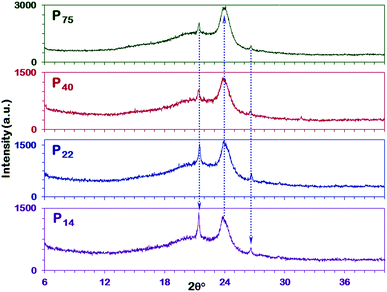 | ||
| Fig. 4 XRD patterns of various thickness PEBAX-1657 membranes. Direction of doted arrows shows the increase in respective peak intensities. | ||
To confirm the above findings, a comparison of XRD results with literature reported studies has been performed. On comparing Fig. 4 and S8, ESI,† we found that the as-fabricated membranes have distinct peaks for PA6 and PEO crystalline phases whereas in earlier reported studies no such distinction has been made. Most of the diffraction patterns in Fig. S8, ESI† show a broad peak ranging from 15–25° with a shoulder or small intensity peak, which implies the irregular packing of the polymer chains. The XRD patterns also evidence the formation of a metastable, helical γ-form type (PA6) structure in these PEBAX membranes. Moreover, these diffraction patterns (Fig. S8, ESI†) display a remarkably lower degree of crystallinity in comparison with P14, P22, P40, and P75 membranes (Fig. 4).
Furthermore, to evaluate the thermal properties, polymeric chain rigidity, crystallization tendency, Tg and Tm (melting temperature) of polymers/segments, DSC analyses were performed. As reported in Fig. S9b (ESI†), the typical peaks of PEO and PA6 crystalline phases establish the semi-crystalline and phase separation characteristics of PEBAX membranes.38 In the case of the PEO segment, a small variation in the melting peak can be noticed. The area of the Tm PEO peak decreases with an increase in the membrane thickness whereas an increase in melting temperature has been observed which depicts the change in the crystallinity of the PEO segment. Moreover, a decrease in Tg values from −52.3 °C to −54.0 with a decrease in membrane thickness indicates the polymeric chain mobility and much regular arrangement. Furthermore, the Tg values reported in Fig. 5b for the PEO segment are much lower than previously reported values for pristine PEBAX membranes, where Xin et al.,35 Li et al.,38 Wang et al.30 and Rahman et al.1 reported −50.4 °C, −51.6 °C, −51.4 °C, and −51.0 °C for pristine PEBAX 1657 membranes, respectively. In addition to variation in the DSC profile of the PEO segment with a change in membrane thickness, a split in the Tm peak of the PA segment for the P75 membrane has also been observed which confirms the dual phase formation (α and γ PA6) during P75 membrane crystallization. Therefore, DSC observation affirms the XRD analysis findings.
![[double bond, length as m-dash]](https://www.rsc.org/images/entities/char_e001.gif) O in-plane bending of the amide group (–C(O)–NHC–). The C–C stretching region is composed of four primary peaks, 1022, 1062, 1072 and 1127 cm−1. The 1062 and 1127 cm−1 peaks are indicative of an all-trans C–C backbone conformation while the 1080 cm−1 peak is attributed to the presence of gauche bonds in the polymeric film. The C–N–H bending region of the Raman spectrum is also sensitive to the conformation (planar or nonplanar) of the amide group. Bands observed in the regions of 1270–1350 and 1440–1490 cm−1 are indicative of different amide conformations. Furthermore, the disappearance or decrease in the intensity of the 1465 cm−1 peak in the spectrum of the P14 membrane evidences the change in the conformation of the polymer. If we go by the explanation given by Giller et al.59 and Stephens et al.63 for PA6, then we can also expect more than one energetically favorable crystalline structure (and/or chain conformations) in PEBAX membranes.
O in-plane bending of the amide group (–C(O)–NHC–). The C–C stretching region is composed of four primary peaks, 1022, 1062, 1072 and 1127 cm−1. The 1062 and 1127 cm−1 peaks are indicative of an all-trans C–C backbone conformation while the 1080 cm−1 peak is attributed to the presence of gauche bonds in the polymeric film. The C–N–H bending region of the Raman spectrum is also sensitive to the conformation (planar or nonplanar) of the amide group. Bands observed in the regions of 1270–1350 and 1440–1490 cm−1 are indicative of different amide conformations. Furthermore, the disappearance or decrease in the intensity of the 1465 cm−1 peak in the spectrum of the P14 membrane evidences the change in the conformation of the polymer. If we go by the explanation given by Giller et al.59 and Stephens et al.63 for PA6, then we can also expect more than one energetically favorable crystalline structure (and/or chain conformations) in PEBAX membranes.
Furthermore, nylon 6 is an important constituent of the PEBAX polymer and it imparts mechanical strength to PEBAX membranes. The –NH(CH2)5(CO)– repeating groups lead to a structure in which the peptide units (NH–CO) provide hydrogen bonding between polymer chains. Although nylon is crystalline, the presence of the crystalline lamella in an amorphous matrix makes it difficult to obtain precise crystallography.64 It has been well documented that nylon 6 exists in mainly two forms of regular crystal structures: α form (with amide bonds parallel to the methylene sheets) and γ form (with amide bonds perpendicular to the methylene sheets), as shown in Fig. 6.58,59,64–66 Out of these two forms, the α form is considered to be more stable than the γ form. If we go by these reported findings for nylon 6, then we can expect that the as-fabricated membranes have a different polymer conformation than that in earlier published reports. Thus, the polymeric chains in the crystalline zone of PEBAX may favor bonding among chains, and the nature of these folds affects the optimum chain spacing, chain structure/configuration, and connection between them. In simple words, the conformation of the PEBAX membrane has a high influence on its single gas permeation performance.
FTIR spectroscopy was used to explore the polymer conformation and interfacial interaction between the polymeric chains in the as-fabricated high permeability PEBAX membranes. Fig. 7 shows the FTIR spectra of the different thickness PEBAX membranes. The inset image in each spectrum reveals that there is a considerable difference between the vibrational peaks of low thickness and high thickness membranes (Fig. 7). A close look at the inset image in Fig. 7 P14 reveals a strong peak at 1461 cm−1 but with the increase in the thickness of the polymeric membrane in the P44 membrane sample, a shoulder appears which further changes to a low intensity peak (1440 cm−1) in the P75 sample. On the other hand, the 1275 cm−1 peak in P14 and P22 polymer films disappeared in P40 and P75 membranes which indicates a change in the polymeric chain arrangement with an increase in the thickness of the membrane. In addition to the disappearance of the 1275 cm−1 peak in the P75 membrane spectrum, a shift in the peak position (to 1245 cm−1), peak broadening and appearance of weak shoulder peaks have also been noticed. Moreover, vibrational peak patterns, especially in the 1200–1500 cm−1 wave number region of the as-fabricated PEBAX membranes, are unquestionably different from the spectra reported by Murali et al.,26 Wang et al.,30 Xiang et al.32 and Li et al.38 The appearance and disappearance of vibrational peaks in the 1200–1500 cm−1 wave number region demonstrate transformation in the polymer chain conformation and interfacial interactions as highlighted in Fig. 7.58,67 The interaction between the two different classes of crystal structures formulated with different polymeric chain packing schemes in nylon 6 can also be considered as a crucial factor for a stable polymeric chain configuration in PEBAX membranes. The FTIR spectrum of the P75 membrane also shows some change in the intensities and position shift of the symmetric stretching vibration peak of the –CH3 group highlighted by a dotted circle. Furthermore, the spectra reported in Fig. 7 reveal an unequivocally better polymeric chain arrangement and chemical structure than earlier reported spectra for pristine PEBAX 1657 membranes.26,32 The sharp and strong bands at 1732 and 1636 cm−1 represent C![[double bond, length as m-dash]](https://www.rsc.org/images/entities/char_e001.gif) O stretching vibration in the two types of amide groups, whereas 1541 cm−1 peaks correspond to N–H deformation of the PA6 segment.38 For the pristine PEBAX membrane, the characteristic peak at 1096 cm−1 is mainly attributed to the C–O stretching vibration of the PEO segment. As reported by Zheng and Xu,67 Ruiz-Hitzky and Aranda,68,69 and Papke et al.,70 the peaks at 949 and 848 cm−1 assigned to the CH2 rocking vibration of methylene groups in a gauche conformation indicate the possible helical structure of the PEO segment in the PEBAX membrane. From the Raman and FTIR spectra discussion, we can conclude that the polymer chain conformation, hydrogen bonding and interaction between polymeric chains play decisive roles in the free space and polymeric membrane performance.
O stretching vibration in the two types of amide groups, whereas 1541 cm−1 peaks correspond to N–H deformation of the PA6 segment.38 For the pristine PEBAX membrane, the characteristic peak at 1096 cm−1 is mainly attributed to the C–O stretching vibration of the PEO segment. As reported by Zheng and Xu,67 Ruiz-Hitzky and Aranda,68,69 and Papke et al.,70 the peaks at 949 and 848 cm−1 assigned to the CH2 rocking vibration of methylene groups in a gauche conformation indicate the possible helical structure of the PEO segment in the PEBAX membrane. From the Raman and FTIR spectra discussion, we can conclude that the polymer chain conformation, hydrogen bonding and interaction between polymeric chains play decisive roles in the free space and polymeric membrane performance.
| Membrane | Density ρp, g cm−3 | Fractional free volume | Specific free volume, cm3 |
|---|---|---|---|
| P14 | 1.129 | 0.134 | 0.119 |
| P22 | 1.133 | 0.131 | 0.116 |
| P40 | 1.144 | 0.123 | 0.107 |
| P75 | 1.146 | 0.121 | 0.105 |
3.3 Single gas permeation performance assessment
| Membrane | Permeability (Barrer) | Selectivity | Gas flux (GPU) | ||||||||
|---|---|---|---|---|---|---|---|---|---|---|---|
| CO2 | N2 | O2 | CH4 | CO2/N2 | CO2/O2 | CO2/CH4 | CO2 | N2 | O2 | CH4 | |
| P14 | 185 | 3.1 | 8.2 | 10 | 60 | 23 | 18 | 9.9 | 0.17 | 0.44 | 0.55 |
| P22 | 148 | 2.7 | 7.1 | 8.8 | 56 | 21 | 17 | 5.7 | 0.11 | 0.28 | 0.35 |
| P40 | 144 | 2.8 | 7.9 | 9.3 | 52 | 18 | 16 | 4.5 | 0.087 | 0.24 | 0.29 |
| P75 | 88.5 | 2.3 | 6.5 | 7.9 | 39 | 14 | 11 | 1.2 | 0.030 | 0.087 | 0.11 |
| P63A | 54.3 | 1.5 | — | 5.3 | 35 | — | 10 | 0.72 | 0.020 | — | 0.070 |
| P56Y | 116 | 3.5 | 12 | 12 | 30 | 10 | 10 | 1.9 | 0.060 | 0.19 | 0.18 |
In order to obtain further insight into the role of the improved characteristics of the membrane in slow solvent evaporation and reduced thickness in gas permeation, the diffusivity and solubility data of the membranes were also measured using the time lag method. As shown in Table S2 (ESI†), the diffusion coefficient for CO2 gas increases for pristine PEBAX membranes as the thickness decreases. The diffusion coefficient of CO2 increases from nearly 1.2 × 10−6 cm2 s−1 for P75 to 2.6 × 10−6 cm2 s−1 for P14 pristine PEBAX membranes. The increase of FFV in both PEO and PA6 segments of pristine PEBAX membranes results in an enormous increase in CO2 diffusivity.30 Car et al.72 reported a CO2 diffusion coefficient of 4.6 × 10−7 cm2 s−1 at 30 °C and 600 mbar feed pressure. Kim et al.73 determined a CO2 diffusion coefficient of 1.52 × 10−6 cm2 s−1 by using a continuous flow technique at 25 °C and 3 atmosphere feed pressure. Furthermore, Wang et al.,30 Xin et al.35 and Reijerkerk et al.36 reported CO2 diffusion coefficients of 1.35 × 10−6 cm2 s−1, 1.43 × 10−6 cm2 s−1 and 7.9 × 10−7 cm2 s−1 for pristine PEBAX membranes, respectively. These comparative diffusivity results illustrated that the as-fabricated PEBAX membranes have a higher specific volume of the polymer in comparison to other reported pristine PEBAX membranes.
4. Conclusions
Nanostructure zeolite molecular sieves (zeolites A and Y) were synthesized for MMM fabrication. Pristine PEBAX membranes of different thicknesses have been fabricated and their single gas permeation performance, polymeric conformation, and chemical structure have been evaluated extensively. The diffraction, thermal and spectroscopic studies assert that solvent evaporation kinetics plays a significant role in the observed polymeric conformation. Moreover, during evaporation, the polymeric film remains in contact with the vapor of the solvent which significantly affects the crystal structure of the resultant polymer. The single gas permeation results demonstrate the high potential of the reported polymeric structure optimization concept to significantly enhance the gas permeability. The optimal 14 μm thickness P14 membrane with high FFV shows very high CO2 permeability (184.7 Barrer) as well as CO2/N2 selectivity (59.7) at 2.7 bar and 25 °C. This paper also demonstrates that the permeability, as well as CO2 selectivity, can be improved by just reforming the polymeric structure without using any inorganic fillers and surfactants. It reveals that the permeability and selectivity improvement is mainly attributed to changes in the polymer conformation and total free volume. Thus, by improving the polymeric structure of PEBAX as well as by reforming the free-volume in the membrane, pristine PEBAX films can absorb CO2 molecules more favorably than N2 molecules. The pristine PEBAX membranes reported in this paper show even better performance than PEBAX based MMMs which encourages us to check the possibilities to fabricate high quality and greater CO2 separation performance membranes.Conflicts of interest
There are no conflicts to declare.Acknowledgements
This work was supported by the Korean CCS R&D Center (KCRC) funded by the Ministry of Science and ICT, Repulic of Korea (Grant No. 2014M1A8A1049310).Notes and references
- M. M. Rahman, S. Shishatskiy, C. Abetz, P. Georgopanos, S. Neumann, M. M. Khan, V. Filiz and V. Abetz, J. Membr. Sci., 2014, 469, 344–354 CrossRef CAS.
- F. M. Enujekwu, C. I. Ezeh, M. W. George, M. Xu, H. Do, Y. Zhang, H. Zhao and T. Wu, Nanoscale Adv., 2019, 1, 1442–1451 RSC.
- V. Zeleňák, M. Skřínska, A. Zukal and J. Čejka, Chem. Eng. J., 2018, 348, 327–337 CrossRef.
- Z. Dai, J. Deng, L. Ansaloni, S. Janakiram and L. Deng, J. Membr. Sci., 2019, 578, 61–68 CrossRef CAS.
- D. Zhao, X.-H. Liu, J.-H. Guo, H.-J. Xu, Y. Zhao, Y. Lu and W.-Y. Sun, Inorg. Chem., 2018, 57, 2695–2704 CrossRef CAS PubMed.
- M. Shan, B. Seoane, A. Pustovarenko, X. Wang, X. Liu, I. Yarulina, E. Abou-Hamad, F. Kapteijn and J. Gascon, J. Membr. Sci., 2018, 566, 213–222 CrossRef CAS.
- E. Knapik, P. Kosowski and J. Stopa, Chem. Eng. Res. Des., 2018, 131, 66–79 CrossRef CAS.
- J. G. Vitillo, B. Smit and L. Gagliardi, Chem. Rev., 2017, 117, 9521–9523 CrossRef CAS PubMed.
- A. Villarreal, G. Garbarino, P. Riani, E. Finocchio, B. Bosio, J. Ramírez and G. Busca, J. CO2 Util., 2017, 19, 266–275 CrossRef CAS.
- Y. Lv, X. Yu, J. Jia, S. T. Tu, J. Yan and E. Dahlquist, Appl. Energy, 2012, 90, 167–174 CrossRef CAS.
- O. Ovalle-Encinia, H. Pfeiffer and J. Ortiz-Landeros, Ind. Eng. Chem. Res., 2018, 57, 9261–9268 CrossRef CAS.
- X. Zhu, Y. Hua, C. Tian, C. W. Abney, P. Zhang, T. Jin, G. Liu, K. L. Browning, R. L. Sacci, G. M. Veith, H.-C. Zhou, W. Jin and S. Dai, Angew. Chem., Int. Ed., 2018, 57, 2816–2821 CrossRef CAS PubMed.
- N. Du, H. B. Park, G. P. Robertson, M. M. Dal-Cin, T. Visser, L. Scoles and M. D. Guiver, Nat. Mater., 2011, 10, 372–375 CrossRef CAS PubMed.
- L. M. Robeson, J. Membr. Sci., 2008, 320, 390–400 CrossRef CAS.
- T. C. Merkel, B. D. Freeman, R. J. Spontak, Z. He, I. Pinnau, P. Meakin and A. J. Hill, Science, 2002, 296, 519–522 CrossRef CAS PubMed.
- Y. Li, S. Wang, H. Wu, J. Wang and Z. Jiang, J. Mater. Chem., 2012, 22, 19617–19620 RSC.
- G. Dong, H. Li and V. Chen, J. Mater. Chem. A, 2013, 1, 4610–4630 RSC.
- S. Luo, K. A. Stevens, J. S. Park, J. D. Moon, Q. Liu, B. D. Freeman and R. Guo, ACS Appl. Mater. Interfaces, 2016, 8, 2306–2317 CrossRef CAS PubMed.
- H. W. Kim, H. W. Yoon, S. Yoon, B. M. Yoo, B. K. Ahn, Y. H. Cho, H. J. Shin, H. Yang, U. Paik, S. Kwon, J.-Y. Choi and H. B. Park, Science, 2013, 342, 91–95 CrossRef CAS PubMed.
- L. Cao, K. Tao, A. Huang, C. Kong and L. Chen, Chem. Commun., 2013, 49, 8513–8515 RSC.
- M. Karunakaran, R. Shevate, M. Kumar and K. V. Peinemann, Chem. Commun., 2015, 51, 14187–14190 RSC.
- M. A. Aroon, A. F. Ismail, T. Matsuura and M. M. Montazer-Rahmati, Sep. Purif. Technol., 2010, 75, 229–242 CrossRef CAS.
- V. Nafisi and M. B. Hägg, ACS Appl. Mater. Interfaces, 2014, 6, 15643–15652 CrossRef CAS PubMed.
- Y. Li, Q. Xin, H. Wu, R. Guo, Z. Tian, Y. Liu, S. Wang, G. He, F. Pan and Z. Jiang, Energy Environ. Sci., 2014, 7, 1489–1499 RSC.
- Y. Wang, H. Li, G. Dong, C. Scholes and V. Chen, Ind. Eng. Chem. Res., 2015, 54, 7273–7283 CrossRef CAS.
- R. Surya Murali, S. Sridhar, T. Sankarshana and Y. V. L. Ravikumar, Ind. Eng. Chem. Res., 2010, 49, 6530–6538 CrossRef.
- B. Yu, H. Cong, Z. Li, J. Tang and X. S. Zhao, J. Appl. Polym. Sci., 2013, 130, 2867–2876 CrossRef CAS.
- T. Li, Y. Pan, K. V. Peinemann and Z. Lai, J. Membr. Sci., 2013, 425–426, 235–242 CrossRef CAS.
- R. Surya Murali, A. F. Ismail, M. A. Rahman and S. Sridhar, Sep. Purif. Technol., 2014, 129, 1–8 CrossRef CAS.
- S. Wang, Y. Liu, S. Huang, H. Wu, Y. Li, Z. Tian and Z. Jiang, J. Membr. Sci., 2014, 460, 62–70 CrossRef CAS.
- P. Dutta, Y. Chen, B. Wang, L. Zhao and W. S. Winston Ho, J. Membr. Sci., 2015, 495, 415–423 CrossRef.
- L. Xiang, Y. Pan, G. Zeng, J. Jiang, J. Chen and C. Wang, J. Membr. Sci., 2016, 500, 66–75 CrossRef CAS.
- A. Ghadimi, T. Mohammadi and N. Kasiri, Ind. Eng. Chem. Res., 2014, 53, 17476–17486 CrossRef CAS.
- P. Bernardo, J. C. Jansen, F. Bazzarelli, F. Tasselli, A. Fuoco, K. Friess, P. Izák, V. Jarmarová, M. Kačírková and G. Clarizia, Sep. Purif. Technol., 2012, 97, 73–82 CrossRef CAS.
- Q. Xin, Y. Zhang, T. Huo, H. Ye, X. Ding, L. Lin, Y. Zhang, H. Wu and Z. Jiang, J. Membr. Sci., 2016, 508, 84–93 CrossRef CAS.
- S. R. Reijerkerk, M. H. Knoef, K. Nijmeijer and M. Wessling, J. Membr. Sci., 2010, 352, 126–135 CrossRef CAS.
- M. Aghajani, A. Kargari, E. Ahmadpour, A. A. Shamsabadi and R. M. Behbahani, J. Nat. Gas Sci. Eng., 2014, 21, 518–523 CrossRef.
- Y. Li, X. Li, H. Wu, Q. Xin, S. Wang, Y. Liu, Z. Tian, T. Zhou, Z. Jiang, H. Tian, X. Cao and B. Wang, J. Membr. Sci., 2015, 493, 460–469 CrossRef CAS.
- C. Nagel, K. Günther-Schade, D. Fritsch, T. Strunskus and F. Faupel, Macromolecules, 2002, 35, 2071–2077 CrossRef CAS.
- N. Petzetakis, C. M. Doherty, A. W. Thornton, X. C. Chen, P. Cotanda, A. J. Hill and N. P. Balsara, Nat. Commun., 2015, 6, 7529 CrossRef CAS PubMed.
- N. R. Horn, J. Membr. Sci., 2016, 518, 289–294 CrossRef CAS.
- P. M. Budd, N. B. McKeown and D. Fritsch, J. Mater. Chem., 2005, 15, 1977–1986 RSC.
- J. R. Wiegand, Z. P. Smith, Q. Liu, C. T. Patterson, B. D. Freeman and R. Guo, J. Mater. Chem. A, 2014, 2, 13309–13320 RSC.
- S. Tan, Q. Fu, J. M. P. Scofield, J. Kim, P. A. Gurr, K. Ladewig, A. Blencowe and G. G. Qiao, J. Mater. Chem. A, 2015, 3, 14876–14886 RSC.
- J. Y. Park and D. R. Paul, J. Membr. Sci., 1997, 125, 23–39 CrossRef CAS.
- Q. Song, S. Cao, R. H. Pritchard, B. Ghalei, S. A. Al-Muhtaseb, E. M. Terentjev, A. K. Cheetham and E. Sivaniah, Nat. Commun., 2014, 5, 1–12 Search PubMed.
- K. Y. Huang, C. L. Shiu, Y. A. Su, C. C. Yang, J. M. Yeh, Y. Wei and K. R. Lee, J. Membr. Sci., 2009, 339, 171–176 CrossRef CAS.
- P. D. Sutrisna, J. Hou, M. Y. Zulkifli, H. Li, Y. Zhang, W. Liang, D. M. D'Alessandro and V. Chen, J. Mater. Chem. A, 2018, 6, 918–931 RSC.
- Y. Wang, T. Hu, H. Li, G. Dong, W. Wong and V. Chen, Energy Procedia, 2014, 63, 202–209 CrossRef CAS.
- E. Esposito, G. Clarizia, P. Bernardo, J. C. Jansen, Z. Sedláková, P. Izák, S. Curcio, B. de Cindio and F. Tasselli, Chem. Eng. Process., 2015, 94, 53–61 CrossRef CAS.
- P. Li, Z. Wang, W. Li, Y. Liu, J. Wang and S. Wang, ACS Appl. Mater. Interfaces, 2015, 7, 15481–15493 CrossRef CAS PubMed.
- L. Liu, A. Chakma and X. Feng, Chem. Eng. J., 2004, 105, 43–51 CrossRef CAS.
- J. Sánchez-Laínez, I. Gracia-Guillén, B. Zornoza, C. Téllez and J. Coronas, New J. Chem., 2019, 43, 312–319 RSC.
- J. C. Jansen, K. Friess and E. Drioli, J. Membr. Sci., 2011, 367, 141–151 CrossRef CAS.
- P. Sharma, J. G. Yeo, M. H. Han and C. H. Cho, RSC Adv., 2012, 2, 7809–7823 RSC.
- B. A. Holmberg, H. Wang, J. M. Norbeck and Y. Yan, Microporous Mesoporous Mater., 2003, 59, 13–28 CrossRef CAS.
- S. A. Habibiannejad, A. Aroujalian and A. Raisi, RSC Adv., 2016, 6, 79563–79577 RSC.
- D. Cho, E. Zhmayev and Y. L. Joo, Polymer, 2011, 52, 4600–4609 CrossRef CAS.
- C. B. Giller, D. B. Chase, J. F. Rabolt and C. M. Snively, Polymer, 2010, 51, 4225–4230 CrossRef CAS.
- Y. Shao, H. Chen, Y. Li and X. Ma, Chem. Eng. J., 2015, 276, 51–58 CrossRef CAS.
- A. Tena, S. Shishatskiy and V. Filiz, RSC Adv., 2015, 5, 22310–22318 RSC.
- S. Garreau, M. Leclerc, N. Errien and G. Louarn, Macromolecules, 2003, 36, 692–697 CrossRef CAS.
- J. S. Stephens, D. B. Chase and J. F. Rabolt, Macromolecules, 2004, 37, 877–881 CrossRef CAS.
- Y. Li and W. A. Goddard, Macromolecules, 2002, 35, 8440–8455 CrossRef CAS.
- D. R. Holmes, C. W. Bunn and D. J. Smith, J. Polym. Sci., 1955, XVII, 159–177 CrossRef.
- H. Arimoto, J. Polym. Sci., Part A: Gen. Pap., 2003, 2, 2283–2295 Search PubMed.
- X. Zheng and Q. Xu, J. Phys. Chem. B, 2010, 114, 9435–9444 CrossRef CAS PubMed.
- E. Ruiz-Hitzky and P. Aranda, Adv. Mater., 1990, 2, 545–547 CrossRef CAS.
- P. Aranda and E. Ruiz-Hitzky, Chem. Mater., 1992, 4, 1395–1403 CrossRef CAS.
- B. L. Papke, M. A. Ratner and D. F. Shriver, J. Phys. Chem. Solids, 1981, 42, 493–500 CrossRef CAS.
- R. Recio, Á. E. Lozano, P. Prádanos, Á. Marcos, F. Tejerina and A. Hernández, J. Appl. Polym. Sci., 2008, 107, 1039–1046 CrossRef CAS.
- A. Car, C. Stropnik, W. Yave and K. V. Peinemann, J. Membr. Sci., 2008, 307, 88–95 CrossRef CAS.
- J. H. Kim, S. Y. Ha and Y. M. Lee, J. Membr. Sci., 2001, 190, 179–193 CrossRef CAS.
- M. Carta, R. Malpass-Evans, M. Croad, Y. Rogan, J. C. Jansen, P. Bernardo, F. Bazzarelli and N. B. McKeown, Science, 2013, 339, 303–307 CrossRef CAS PubMed.
Footnote |
| † Electronic supplementary information (ESI) available. See DOI: 10.1039/c9na00170k |
| This journal is © The Royal Society of Chemistry 2019 |

